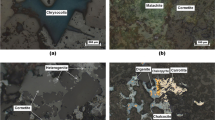Abstract
Material characteristics of pure copper, pure cobalt and Cu–Co metal-powder composite were comparative studied through biomachining by Acidithiobacillus ferrooxidans (A. ferrooxidans) in three groups of culture solutions. Material removal mechanisms of Cu–Co metal-powder composite involved in biomachining were explored. It was first observed that the pure cobalt and Cu–Co metal-powder composite were machined by the A. ferrooxidans. The material removal of three workpieces presented linear increase along the machining process due to the metabolic activity of the A. ferrooxidans. Different with the pure metal, the material removal mechanism of Cu–Co metal-powder is explained by the dual effect of micro-galvanic corrosion and participation of Cu2+ and Fe3+ for oxidization of cobalt.














Similar content being viewed by others
Abbreviations
- A. ferrooxidans :
-
Acidithiobacillus ferrooxidans
- ΔE0 :
-
Standard reduction potential of demi-reaction
References
Diaz-Tena, E., Barona, A., Gallastegui, G., Rodriguez, A., Lopez, D. L. L., & Elias, A. (2017). Biomachining: Metal etching via microorganisms. Critical Reviews in Biotechnology, 37, 323–332.
Muhammad, I., Sana Ullah, S. M., Han, D. S., & Ko, T. J. (2015). Selection of optimum process parameters of biomachining for maximum metal removal rate. International Journal of Precision Engineering and Manufacturing-Green Technology, 2, 307–313.
Muhammad, I., Khatoon, T., Ullah, S. M. S., & Ko, T. J. (2018). Development of empirical model for biomachining to improve machinability and surface roughness of polycrystalline copper. International Journal of Precision Engineering and Manufacturing-Green Technology, 5, 201–209.
Díaz-Tena, E., Gallastegui, G., Hipperdinger, M., Donati, E. R., & Ramírez, M. (2016). New advances in copper biomachining by iron-oxidizing bacteria. Corrosion Science, 112, 385–392.
Díaz-Tena, E., Rojo, N., Gurtubay, L., Rodríguez-Ezquerro, A., López De Lacalle, L. N., Oyanguren, I., et al. (2017). Biomachining: Preservation of Acidithiobacillus Ferrooxidans and treatment of the liquid residue. Engineering in Life Sciences, 17, 382–391.
Uno, Y., Kaneeda, T., & Yokomizo, S. (1996). Fundamental study on biomachining (Machining of Metals by Thiobacillus Ferrooxidans). JSME International Journal Ser C, 39, 837–842.
Zhang, D. Y., & Li, Y. Q. (1998). Possibility of biological micromachining used for metal removal. Science in China, Series C: Life Sciences, 41, 151–156.
Lilova, K., Karamanev, D., Flemming, R. L., & Karamaneva, T. (2007). Biological oxidation of metallic copper by Acidithiobacillus Ferrooxidans. Biotechnology and Bioengineering, 97, 308–316.
Liu, Y. D., Wang, X. B., Yang, Y., & Shi, W. T. (2009). Processing micro-gear based on bio-etching method. Applied Mechanics and Materials, 16–19, 120–123.
Istiyanto, J., Saragih, A., & Ko, T. J. (2012). Metal based micro-feature fabrication using biomachining process. Microelectronic Engineering, 98, 561–565.
Díaz-Tena, E., Rodríguez-Ezquerro, A., De Lacalle, López, Marcaide, L. N., Gurtubay Bustinduy, L., & Elías Sáenz, A. (2014). A sustainable process for material removal on pure copper by use of extremophile bacteria. Journal of Cleaner Production, 84, 752–760.
Jadhav, U. U., Hocheng, H., & Weng, W. (2013). Innovative use of biologically produced ferric sulfate for machining of copper metal and study of specific metal removal rate and surface roughness during the process. Journal of Materials Processing Technology, 213, 1509–1515.
Hocheng, H., Chang, J. H., Hsu, H. S., Han, H. J., Chang, Y. L., & Jadhav, U. U. (2012). Metal removal by acidithiobacillus ferrooxidans through cells and extra-cellular culture supernatant in biomachining. CIRP Journal of Manufacturing Science and Technology, 5, 137–141.
Hocheng, H., Chang, J., & Jadhav, U. U. (2012). Micromachining of Various Metals by Using Acidithiobacillus Ferrooxidans 13820 Culture Supernatant Experiments. Journal of Cleaner Production, 20, 180–185.
Hocheng, H., Jadhav, U. U., & Chang, J. H. (2012). Biomachining rates of various metals by Acidithiobacillus Thiooxidans. International Journal of Surface Science and Engineering, 6, 101–111.
Chang, J. H., Hocheng, H., Chang, H. Y., & Shih, A. (2008). Metal removal rate of Thiobacillus Thiooxidans without pre-secreted metabolite. Journal of Materials Processing Technology, 201, 560–564.
Silverman, M. P., & Lundgren, D. G. (1959). Studies on the chemoautotrophic iron bacterium FERROBACILLUS FERROOXIDANS I.: An improved medium and a harvesting procedure for securing high cell yields. Journal of Bacteriology, 77, 642–647.
Yun, H. G., Kim, M., Kang, M. G., & Lee, I. H. (2012). Cost-effective dye-sensitized solar cells consisting of two metal foils instead of transparent conductive oxide glass. Physical Chemistry Chemical Physics, 14, 6448–6451.
Vidal-Iglesias, F. J., Solla-Gullón, J., Rodes, A., Herrero, E., & Aldaz, A. (2012). Understanding the nernst equation and other electrochemical concepts: An easy experimental approach for students. Journal of Chemical Education, 89, 936–939.
May, N., Ralph, D. E., & Hansford, G. S. (1997). Dynamic redox potential measurement for determining the ferric leach kinetics of pyrite. Minerals Engineering, 10, 1279–1290.
Della Rovere, C. A., Alano, J. H., Silva, R., Nascente, P. A. P., & Otubo, J. (2012). Kuri SE characterization of passive films on shape memory stainless steels. Corrosion Science, 57, 154–161.
Lambert, F., Gaydardzhiev, S., Léonard, G., Lewis, G., Bareel, P., & Bastin, D. (2015). Copper leaching from waste electric cables by biohydrometallurgy. Minerals Engineering, 76, 38–46.
Acknowledgements
The authors would like to acknowledge the East China University of Technology for supplying the culture of A. ferrooxidans.
Funding
The authors would like to thank the financial supports from the National Natural Science Foundation of China (Grant Nos. 51235004 and 51375179) and Science and Technology Projects of Fujian Province (2017H6014).
Author information
Authors and Affiliations
Corresponding author
Additional information
Publisher's Note
Springer Nature remains neutral with regard to jurisdictional claims in published maps and institutional affiliations.
Rights and permissions
About this article
Cite this article
Ma, F., Huang, H. & Xu, X. Material Removal Mechanisms of Cu–Co Metal-Powder Composite by Microorganisms. Int. J. of Precis. Eng. and Manuf.-Green Tech. 7, 975–986 (2020). https://doi.org/10.1007/s40684-019-00110-8
Received:
Revised:
Accepted:
Published:
Issue Date:
DOI: https://doi.org/10.1007/s40684-019-00110-8




